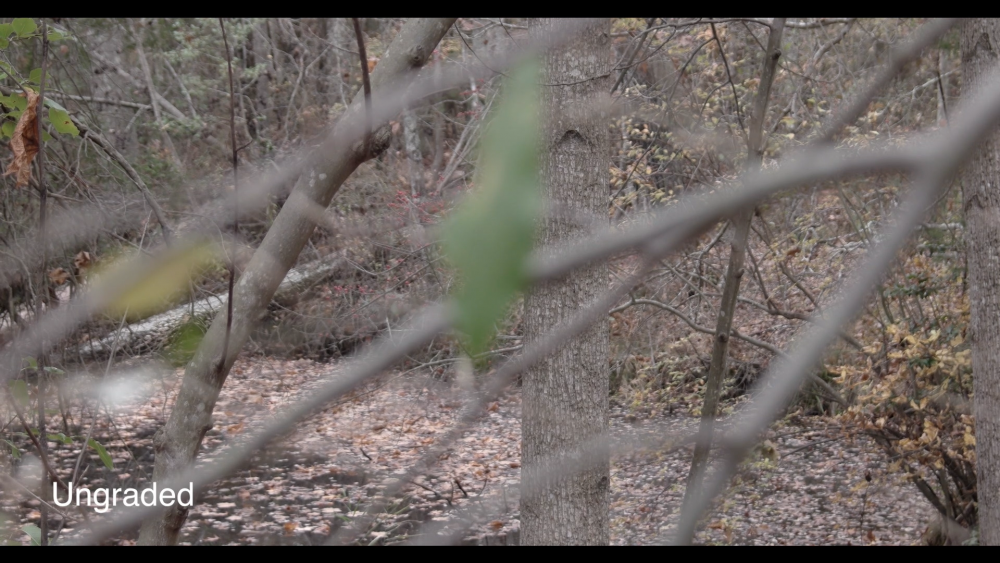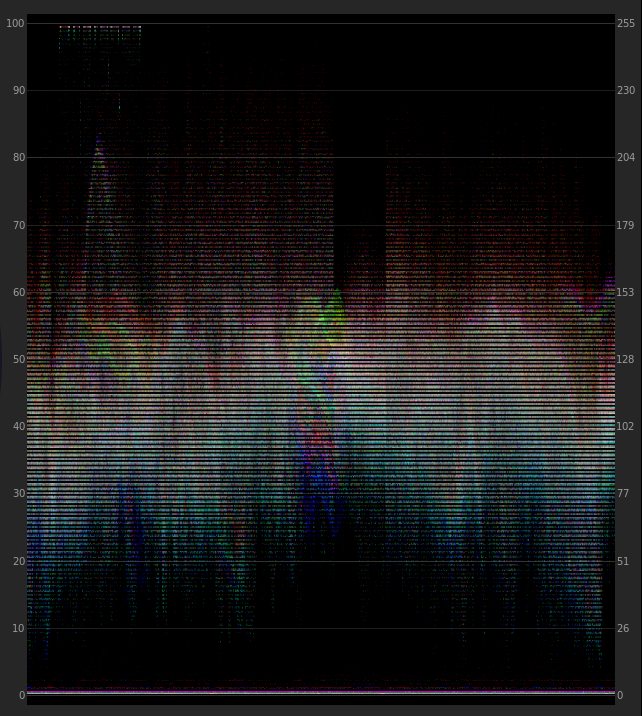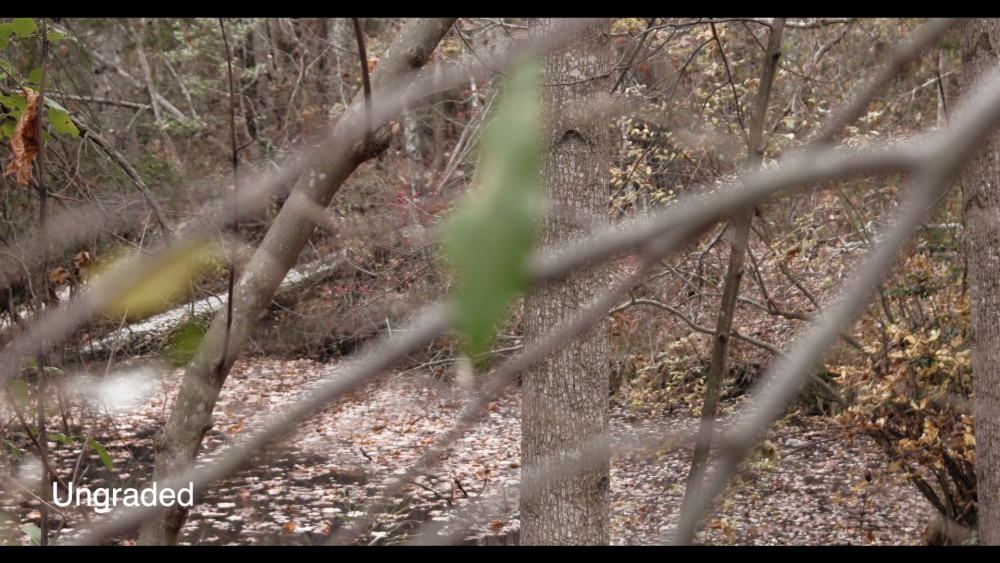
Sekhar
Members-
Posts
389 -
Joined
-
Last visited
Content Type
Profiles
Forums
Articles
Everything posted by Sekhar
-
Well, grading (not color correction) is a personal thing, so if you like high contrast, then you go for high contrast...what the rest of us think means squat. Having said that, you do need to watch the whole clip for the lows and highs. E.g., you say the lows are at 10 mark, but that is only at the beginning; if you scrub forward, you'll see the level touch 0, and that part is going to be too dark if you corrected for the beginning. Anyway, if your goal is to increase contrast, once you set the lift/gain to adjust low/high levels, you might want to try reducing gamma for the lows and increasing it for highs. That will increase contrast, but in a much more subtle way. E.g., see below for for what happens to your clip if we do that (I also increased the saturation a bit). It is for illustrating the gamma adjustments only and may be nothing like what you want or meant to be pleasing in general.
-
I actually like the ungraded footage, except for saturation, which seems too low. I think sharpness -10 and contrast -5 are the best general purpose settings for both NX1 and NX500 (those are what I regularly use, along with Gamma DR on the NX1). IMO reducing saturation is pointless if you're doing post work since that's the easiest thing to tweak without introducing artifacts. Your graded footage is way too saturated anyway, so I'm not sure how reducing it while shooting and then increasing in post helps at all. IMO your grade also seems a bit too contrasty.
-
Won't you miss 4K? My understanding is that you'll need a $$$ interface and recorder to be able to get 4K out of the FS700. But if you're going to sell the 1Dc, I guess now is a good time, though I wonder if FS700 is equally out of date.
-
Grandpas or not, I wouldn't pay much attention or give credence to stats about users that put Canon and Apple in the same pool as camera brands.
-
Oh no, Xavier, by story I meant any coherent message that the images speak as a whole, the subtext, the underlying message that talks to us as humans at a higher, intellectual level rather than at a purely sensory (visual/auditory) level. E.g., many interpreted even the little pizza rat clip as an underdog "story." A more obvious example is of the buffalo that saved its calf from lions that clearly has a "story" I'm talking about (a beginning, middle, and end, to use the cliche). If there was such a message in Watchtower of Turkey, I didn't get it. It seemed to me like a juxtaposition/collage of beautiful images, much like a Victoria's Secret fashion show. E.g., frenetic cuts like that can indicate a frenzy of wild activity, but I don't believe that's what this filmmaker intended for the tourist viewers. What then was the purpose of this kind of cut other than to look cool and generate discussions like this? Anyway, I sense clear disdain and disapproval of my comments here (talking of subtext, I can easily read "what the heck do you know?"). But guys, rather than immediately push back, please consider what I said and discuss because we're all trying to be better filmmakers, and I for myself might be missing an important point here.
-
Wow, congrats! I like the look of your shots, and the trailer is intriguing. What's the status of this, release wise?
-
May be, but the Pizza Rat video shot with cell phone has 8+ million views and caused an Internet sensation, so views mean squat. My point is, to use the cliche: content is king, and there ain't a story in this one. The problem with telling a story is that it's hard, and like exercise folks will resort to all kinds of tricks to avoid it: slow-mo, time-lapse, drone shots, macros, crazy cutting, night for day, bizarre stunt go-pro shots, you name it. Basically do anything gee-wiz to distract the viewer from realizing that there is no story. As I said, the footage is lovely in this piece, so kudos for that. But being great at shooting video is NOT the same being great at telling a story. And storytelling matters a lot to indie filmmakers here, much more so than the gee-wiz stuff.
-
Lovely footage and grading, but the cutting seems crazy for anything longer than a quick (30 second max) promo...I wonder if some would even get seizures. Overall, looks to me like a cop out gimmick from having to tell a story. A shame because the shots are great.
-
Samsung has released the next promo short for its NX!: The Curator. It's way better than the previous "Yvonne" short, and I still need to go through it end-to-end, but it looked generally good in my first quick view. The things I immediately disliked though were: it's overly sharp (I wonder if they left it at default 0), has too many spots with blown highlights that draw attention, and the grading is both inconsistent and unappealing (to me). Please share your opinions.
-
Thanks. One thing I did last time was interview a couple of folks to explain the event, and I ran most of the interview as voiceover as I showed shots of the event...that made things very clear. In this video, I'm actually pretty happy for coming up with a semblance of a story for the last (Playworks) part: it was quite chaotic, and I had to come up with creative ways to cut it together. WRT settings, I used gamma DR with sharpness -10 and contrast -5. These settings have worked best for me in high contrast scenes (there were pretty strong highlights). For a couple of the shots that had low contrast scenes, I did try a higher contrast setting to minimize banding, but didn't quite like the result. The lens was Samsung 16-50 S.
-
Yeah, I had to cover this event without knowing what to focus on or what would be happening, so tried to make a story out of whatever I captured. The first two parts (award and brief intro) are easy, but the Playworks one I tried to make it a meaningful and coherent segment out of different pieces I had. Oh well, something to prepare for next time. Thanks a lot for the feedback!
-
That's funny...I didn't know about The Master, but after your comment checked it out. Anyone wish to share opinions on the video? I'd really appreciate it. I know the audio is not great, but anything else? I was especially hoping to get input on how it's put together. Every so often I cover events like this, and I usually shoot only a small part of a day-long event and end up having to come up with something that the folks can use to promote their org. The problem is that it's a challenge to make the videos engaging, so I'm trying different techniques.
-
Folks, I recently covered a local event in Los Angeles with my NX1. It was indoor and the fluorescent lighting didn't really help, but I did get the chance test out the new DIS to go around the room for covering the action. IMO the shots were steady enough to be usable in situations like this, and I'll be using it more in the future for sure. I didn't do much grading on this except for some level adjustments and color correction for skin (the footage seemed pretty fragile). Please let me know what you think of both the content and how I put it together (I also created the soft background music).
-
You should be able to match the lights with gels. E.g., I do that with blue gels on my Lowel tungstens when adding to sunlight. My bigger concern with cheap lights is bad CRI, which you can't fix with color correction.
-
If a manufacturer tweaks the colors to make them more aesthetically appealing (like as you say Canon making them "pretty"), that by definition is not science but art...that is the point. If you're saying the principles they use to achieve that are scientific, so is every single thing that happens in this universe.
-
Yeah, when folks say "it has good color science," they usually just mean "I like its colors." It's one of the scientific sounding terms people use to express an opinion as fact and to sound credible. The term "color science" seems to be especially popular with Canon lovers and Sony haters (I do personally prefer Canon colors to Sony's BTW).
-
Did you just try the built-in mic? I recorded an event once on my Google Nexus 5 phone with the built-in mic and the RecForge II app, and the quality was surprisingly good. It wasn't quite as flat as my Audio Technica AT-897, but for voice it was great. I suggest you try that first before investing...would be super portable too.
-
I use waveform and vectorscope.(YUV). I prefer waveform to RGB parade because: You get the whole width for each color, whereas in an RGB parade you split the widthYou can tell if the color is neutral for the area you want by checking if the colors in the waveform overlap at the area to show white...can't do that with paradeAnd I always also use vectorscope. It is invaluable for checking a bunch of things, like color casts, skin color, over saturation, etc. IMHO curves are for still photography, not video. And I believe folks who use curves in grading are old timers who are just more familiar and comfortable with them. You can never get the kind of 12 dimensional control you can get with lift/gamma/gain x overall/shadows/midtones/highlights combination. They can be useful in some special situations though, as well as act as poor-man's LUTs that you can store and apply each time to your footage.
-
Generally speaking, you'll want the luma adjustments out of the way first as they can drastically affect color. I.e., adjust the lift (AKA offset)/gamma/gain for the overall/lows/mids/highs as appropriate first, and then work on the colors. Unfortunately, it's not a strict 1-2 order since the levels can shift too as you make color changes, but that is typically not as drastic as the effect of levels on color. So, adjust levels first, then colors, and go back/forth as necessary till you have both the levels and colors the way you want. I agree it's best to have NR first in stacking, but you might end up having to do it last (or disable it as you grade) since the previews can be dog slow if you have it enabled.
-
The problem with AWB is that it varies from shot to shot, making shot matching a challenge in post. If the lighting is non-standard (say you aren't using regular tungsten or day light, and standard profiles don't work), I suggest going with custom WB or even manual K setting.
-
Thanks, that's what I'm doing now, but it's of limited use. In fact, if you're focusing in stills mode, you don't even need peaking since you zoom in quite nicely, making it really easy to focus just by looking. What would be great is a way to focus while in video mode as people (and you) move and need continuous focusing. The 16-50 does a fantastic job for that with MF, but I'm not aware of a way to do it with adapters. The weird thing is: you CAN do it (peaking in video with adapter) on the LCD, just not in the EVF. I wonder why Samsung limited it that way, may be they'll add that in a future update.
-
You guys are all so sweet. Maybe we need a separate critique section on EOSHD, where the focus is on improving and we don't need to hold back on what we really think. I've made a few shorts, and I fully understand how incredibly hard it is to put together anything. But IMO we do a disservice if we praise for encouragement's sake alone, even if we mean well. Obviously I don't know what you actually feel about this short, but some of the comments here can only be for encouragement. John, I hope you took my comments in the spirit of this post.
-
Yes, focusing in photo mode is fine, but the real value of peaking IMO is in video mode as people move in the scene and you need to continuously re-focus. Once you have say the face in focus (like you suggested, using magnification in photo mode), it shouldn't be too hard to maintain the focus though, even with the peaking without magnification.
-
Sorry John, I didn't get this short. Who is this guy? If he's "the last man who lived on earth," how did he come to be that way? Or was it a metaphor? Why does he get excited with the simplest of things if this is the future we're talking about? Where did this girl suddenly come from in the end, not to mention the second robot? What is the underlying message of the short? I also got confused by the music, I'm not sure it jibed with your intent. Overall, a very strange short. But then, may be that's what makes you more creative than the rest. Good luck and keep us posted on what you do with this.
-
I've found the focus peaking to be pretty accurate with the 16-50, though it can be a bit tricky at the wide end since so many parts of the frame show the peaking. I generally have to go back/forth till the peaking is maximum at the point I want. Also, hunting has reduced quite a bit with the latest firmware update. I covered an event a few weeks back, and it held pretty steady. Do you have the latest update?





